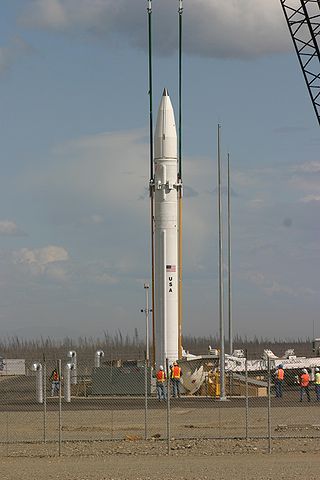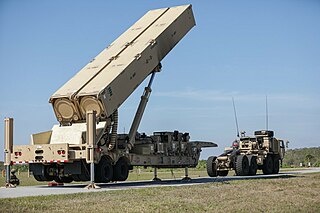Related Research Articles

The AGM-88 HARM is a tactical, air-to-surface anti-radiation missile designed to home in on electronic transmissions coming from surface-to-air radar systems. It was originally developed by Texas Instruments as a replacement for the AGM-45 Shrike and AGM-78 Standard ARM system. Production was later taken over by Raytheon Corporation when it purchased the defense production business of Texas Instruments.

The Northrop B-2 Spirit, also known as the Stealth Bomber, is an American heavy strategic bomber, featuring low-observable stealth technology designed to penetrate dense anti-aircraft defenses. A subsonic flying wing with a crew of two, the plane was designed by Northrop as the prime contractor, with Boeing, Hughes, and Vought as principle subcontractors, and was produced from 1987 to 2000. The bomber can drop conventional and thermonuclear weapons, such as up to eighty 500-pound class (230 kg) Mk 82 JDAM GPS-guided bombs, or sixteen 2,400-pound (1,100 kg) B83 nuclear bombs. The B-2 is the only acknowledged in-service aircraft that can carry large air-to-surface standoff weapons in a stealth configuration.

A cruise missile is an unmanned self-propelled guided vehicle that sustains flight through aerodynamic lift for most of its flight path and whose primary mission is to place an ordnance or special payload on a target. Cruise missiles are designed to deliver a large warhead over long distances with high precision. Modern cruise missiles are capable of traveling at high subsonic, supersonic, or hypersonic speeds, are self-navigating, and are able to fly on a non-ballistic, extremely low-altitude trajectory.

The Northrop Grumman RQ-4 Global Hawk is a high-altitude, remotely-piloted surveillance aircraft introduced in 2001. It was initially designed by Ryan Aeronautical, and known as Tier II+ during development. The RQ-4 provides a broad overview and systematic surveillance using high-resolution synthetic aperture radar (SAR) and electro-optical/infrared (EO/IR) sensors with long loiter times over target areas.

Northrop Grumman Corporation is an American multinational aerospace and defense technology company. With 95,000 employees and an annual revenue in excess of $30 billion, it is one of the world's largest weapons manufacturers and military technology providers. The firm ranked No. 101 on the 2022 Fortune 500 list of America's largest corporations.

The DARPA FALCON Project was a two-part joint project between the Defense Advanced Research Projects Agency (DARPA) and the United States Air Force (USAF) and is part of Prompt Global Strike. The first part of the project aimed to develop a Small Launch System (SLS) capable of accelerating hypersonic gliding weapons as well as launching small satellites into Earth orbit. The second part of the project aimed to develop Hypersonic Weapon Systems (HWS): a short term high performance hypersonic gliding weapon previously named the X-41 Common Aero Vehicle (CAV) that could be launched from Expendable Launch Vehicles (ELV), Reusable Launch Vehicles (RLVs), Hypersonic Cruise Vehicles (HCV), or Space Maneuvering Vehicles (SMP), and a long term hypersonic cruise aircraft named the Hypersonic Cruise Vehicle (HCV). This two-part program was announced in 2003 and continued into 2006.
Scramjet programs refers to research and testing programs for the development of supersonic combustion ramjets, known as scramjets. This list provides a short overview of national and international collaborations, and civilian and military programs. The USA, Russia, India, and China (2014), have succeeded at developing scramjet technologies.

Hypersonic flight is flight through the atmosphere below altitudes of about 90 km at speeds greater than Mach 5, a speed where dissociation of air begins to become significant and high heat loads exist. Speeds over Mach 25 have been achieved below the thermosphere as of 2020.

The Lockheed Martin SR-72, colloquially referred to as "Son of Blackbird", is an American hypersonic UAV concept intended for intelligence, surveillance and reconnaissance (ISR) proposed privately in 2013 by Lockheed Martin as a successor to the retired Lockheed SR-71 Blackbird. In 2018, company executives said an SR-72 test vehicle could fly by 2025 and enter service in the 2030s.

The Ground-Based Interceptor (GBI) is the anti-ballistic missile component of the United States' Ground-Based Midcourse Defense (GMD) system.
The AGM-181 Long Range Stand Off Weapon (LRSO) is a nuclear-armed air-launched cruise missile under development by Raytheon Technologies that will replace the AGM-86 ALCM.

The LGM-35 Sentinel, also known as the Ground Based Strategic Deterrent (GBSD), is a future American land-based intercontinental ballistic missile system (ICBM) currently in the early stages of development. It was slated to replace Minuteman III missiles from 2029 through 2075. The Minuteman missiles are currently stationed in North Dakota, Wyoming, Montana, and Nebraska.

A hypersonic weapon is a weapon capable of travelling at hypersonic speed, defined as between 5 and 25 times the speed of sound or about 1 to 5 miles per second.

The AGM-183 ARRW is a hypersonic air-to-ground ballistic missile planned for use by the United States Air Force. Developed by Lockheed Martin, the boost-glide vehicle is propelled to a maximum speed of more than Mach 5 by a rocket motor before gliding toward its target. The program was cancelled in March 2023 after multiple failed tests. The program, however, continued despite the cancellation and was announced to still be in development following additional, undisclosed testing. However in 2024 it was announced that in the fiscal year 2025 budget, no funding would be provided for procurement or further research and development.

The Long-Range Hypersonic Weapon (LRHW) is a medium-range surface-to-surface hypersonic weapon being developed for use by the United States Army. The United States Navy intends to procure a ship/submarine-launched variant of the missile as part of the service's Intermediate-Range Conventional Prompt Strike (IRCPS) program. The weapon consists of a large rocket booster that carries the unpowered Common-Hypersonic Glide Body (C-HGB) in a nose cone. Once the booster reaches significant altitude and speed, it releases the C-HGB, which glides at hypersonic speeds as it descends towards its target. Dynetics will build the hypersonic glide vehicle while Lockheed Martin will build the booster as well as assemble the missile and launch equipment.

The Space Development Agency (SDA) is a United States Space Force direct-reporting unit tasked with deploying disruptive space technology. One of the technologies being worked on is space-based missile tracking using large global satellite constellations made up of industry-procured low-cost satellites. The SDA has been managed by the United States Space Force since October 2022. By February 2024 the SDA had 33 satellites on orbit. SDA intends to have at least 1,000 satellites in low Earth orbit by 2026.

The Hypersonic Air-breathing Weapon Concept is a scramjet powered hypersonic air-launched cruise missile project at the U.S. Defense Advanced Research Projects Agency (DARPA), that had a successful hypersonic flight announced in September 2021. It is a kinetic energy weapon, without an explosive warhead.
SCIFIRE, or the Southern Cross Integrated Flight Research Experiment, is an American-Australian military technology partnership that is developing a solid-rocket-boosted, air-breathing, hypersonic conventional cruise missile that can be launched by existing fighter or bomber aircraft.

Operational Fires is a hypersonic ground-launched system developed by DARPA for the United States Armed Forces. The system deploys a boost glide vehicle. The prime contractor for the program is Lockheed Martin. The missile's range is thought to be up to 1,000 miles.
The Stand-in Attack Weapon (SiAW) is a tactical air-to-surface missile under development for the United States Air Force (USAF) by Northrop Grumman.
References
- ↑ Trevithick, Joseph. "B52 needs new pylons to carry max load of hypersonic missiles". The Warzone.
- 1 2 Tegler, Eric. "Is DOD's approach to buying hypersonic weapons too expensive?". Forbes.
- ↑ "U.S. Hypersonic Weapons and Alternatives" (PDF). Congressional Budget Office.
- ↑ "Hypersonic missile integration with aircraft". August 14, 2023.
- 1 2 Bugos, Shannon. "First U.S. Hypersonic Deployment on Track for 2023". ArmsControl.org.
- ↑ "Air Force announces hypersonic missile contract award". Eglin Air Force Base.[ permanent dead link ]
- ↑ "Successful HAWC Test Doesn't End DARPA's Hypersonic Scramjet Efforts". Air Force Magazine. July 22, 2022.
- 1 2 Leone, Dario (March 22, 2023). "The USAF Won't Purchase Hypersonic Missiles in 2024". The Aviation Geek Club. Retrieved April 2, 2024.
- ↑ "US Air Force selects Raytheon Missiles & Defense, Northrop Grumman to deliver first hypersonic air-breathing missile". RTX.com. September 22, 2022.
- ↑ "Raytheon/Northrop Grumman team selected for HACM hypersonic weapon". Janes Information Services . September 26, 2022. Archived from the original on September 26, 2022.
- ↑ "US Air Force Selects Raytheon Missiles & Defense, Northrop Grumman to Deliver First Hypersonic Air-Breathing Missile". Northrop Grumman Newsroom.
- 1 2 Losey, Stephen (March 19, 2024). "US Air Force conducts final test of Lockheed's hypersonic missile". Defense News. Retrieved April 2, 2024.
- ↑ "First U.S. Hypersonic Deployment on Track for 2023 | Arms Control Association". www.armscontrol.org. Retrieved April 2, 2024.
- ↑ Losey, Stephen (March 28, 2023). "ARRW hypersonic missile test failed, US Air Force admits". C4ISRNet. Retrieved April 2, 2024.
- ↑ Audrey Decker (28 Mar 2023) Failed Hypersonic Test Dims Air Force View of Lockheed Missile Air Force R&D funding for ARRW and HACM tests is $150 million and $380 million, respectively. "ARRW and HACM are just two of the U.S. military's hypersonic efforts; in all, the Pentagon is requesting $11 billion for hypersonic R&D in 2024"
- ↑ Air Force Pulls Plug On Much-Hyped Hypersonic Missile. The Drive/The War Zone. 30 March 2023.